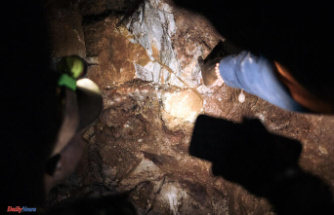It has aroused unexpected enthusiasm in the four corners of the globe: the mysterious inscription engraved 250 years ago on a rock in Plougastel-Daoulas, in Finistère, is beginning to reveal its history thanks to a competition whose results were revealed on Monday. "Today, we have taken a big step", welcomed Dominique Cap, mayor of Plougastel-Daoulas, near Brest, after revealing at a press conference the names of the joint winners of this competition aimed at to propose a translation of this inscription.
“We have a totally different journey but we still arrive at a background of history which is similar, that of a sailor who perished at sea and of a loved one who had this stone carved in his homage”, explained the city councilor about the two hypotheses retained by the jury of this competition launched by the small town. For the two winning teams, it is a text in Breton and the dates correspond to the moments of the events and the engraving.
READ ALSO >> The Breton flag arrives as an emoji on Twitter, and is a hit
"The stone has been engraved for 250 years and until now its mystery had never been unraveled", underlined Dominique Cap, welcoming the success of the operation called "The Champollion mystery", named after the scientist considered as the father of Egyptology, who first deciphered the hieroglyphs of the Rosetta Stone.
From its launch last May, the operation had aroused the enthusiasm of the national press, but also international with more than 200 articles, according to the municipality, in French, English, Spanish, Norwegian, but also German, Italian, Portuguese and Japanese. “It overwhelmed us a little bit”, admitted to the press Véronique Martin, project manager for the town of 13,000 inhabitants, explaining that she had received 2,000 requests to participate. In the end, nearly 600 people validated their registration for this competition with an envelope of 2000 euros.
The jury, made up in particular of historians, selected two hypotheses among the 61 selected as of November 30 and coming mainly from France, but also from Brazil, the United States, Thailand, Russia, Spain, Italy or the United Arab Emirates. The first hypothesis, advanced by Noël René Toudic, associate professor of English and graduate in Celtic studies, evokes a soldier, Serge Le Bris, who would have perished at sea during a storm.
Another soldier, Grégoire Haloteau, would have been responsible for engraving the text in honor of the deceased. "...Serge died when badly exercised in rowing last year his boat was overturned by the wind...", proposes in particular the professor, who judges his proposal to be "80% accurate". The second, issued by Roger Faligot, reporter and writer, and Alain Robet, cartoonist and author of comics, mentions a person expressing his anger against those responsible for the death of a friend.
READ ALSO >> Mystery of rabbits killed in Brittany: the trail of stray dogs
Located on a beach only accessible at low tide, the rock is entirely engraved on one of its faces, mostly with capital letters, but also with drawings, including a sailboat with its mast and rudder. Also included are dates, including 1786 and 1787, roughly corresponding to the years of construction of the various batteries that protected the harbor of Brest. ROC AR B... DRE AR GRIO SE EVELOH AR VIRIONES BAOAVEL... R I or even OBBIIE: BRISBVILAR... FROIK...AL, next to a heart surmounted by a cross, can we read in particular on the imposing rock on the side of the cliff.
"There is still a long way to go to completely unravel the mystery", however, underlined Dominique Cap, specifying that certain parts of the text could not be deciphered and that it still remained to try to identify the two soldiers. However, the municipality already intends to highlight the rock by making it more accessible and by making a reproduction of it for its Strawberry and Heritage Museum.












